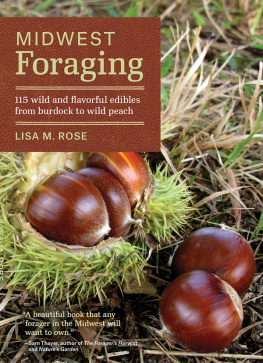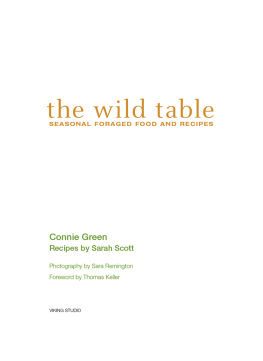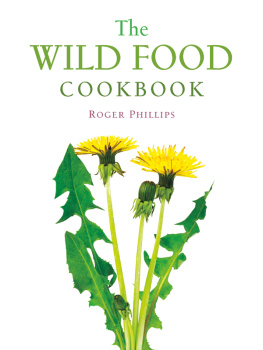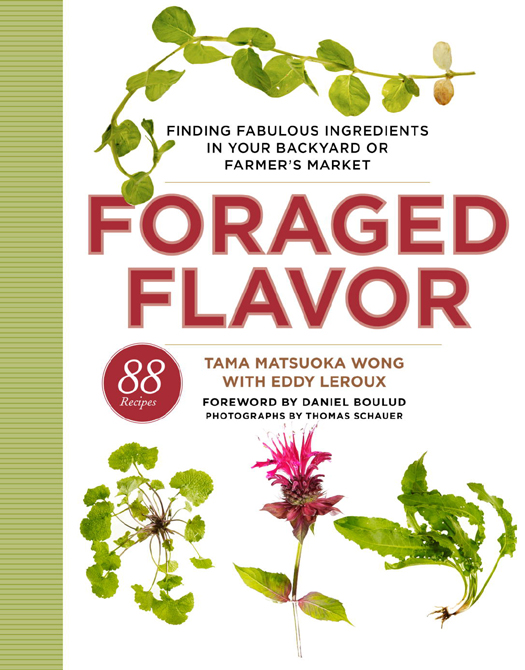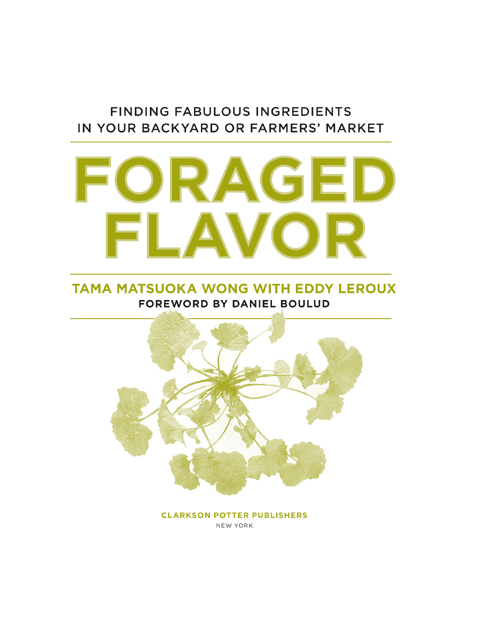It is the responsibility of the reader to identify and correctly use
the edible plants described in this book. The authors and
publisher assume no responsibility for any adverse effects that
may result from the readers misidentification or incorrect use of
such edible plants.

Copyright 2012 by Tama Matsuoka and Eddy Leroux
Photographs copyright 2012 by Thomas SchauerStudio for Photography LLC
Illustrations copyright 2012 by Kate McKeon
All rights reserved.
Published in the United States by Clarkson Potter/Publishers,
an imprint of the Crown Publishing Group, a division of
Random House, Inc., New York.
www.crownpublishing.com
www.clarksonpotter.com
CLARKSON POTTER is a trademark and POTTER with
colophon is a registered trademark of Random House, Inc.
Library of Congress Cataloging-in-Publication Data
Wong, Tama Matsuoka.
Foraged flavor : finding fabulous ingredients in your backyard
or farmers market, with 88 recipes / Tama Matsuoka Wong with
Eddy Leroux; foreword by Daniel Boulud.
p. cm.
(hardback)
1. Cooking (Wild foods) 2. Cooking, American. 3. Wild
plants, Edible. I. Leroux, Eddy. II. Title.
TX823.W65 2012
581.632dc23 2011036334
eISBN: 978-0-307-95662-0
Book design by Marysarah Quinn
Jacket design by Marysarah Quinn
Jacket photographs by Thomas Schauer
v3.1
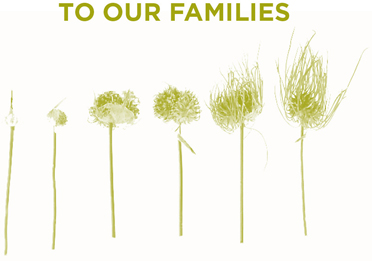
What would the world be, once bereft
Of wet and of wildness?
Let them be left,
O let them be left, wildness and wet;
Long live the weeds and the wilderness yet.
G ERARD M ANLEY H OPKINS
I believe a leaf of grass is no less than the journey-work of the stars,
And the pismire is equally perfect, and a grain of sand, and the egg of the wren,
And the tree-toad is a chef-doeuvre for the highest,
And the running blackberry would adorn the parlors of heaven
W ALT W HITMAN
Foraging is about harvesting the wild, ephemeral, and rare flavors found in nature. As chefs, were always looking for ingredients to inspire us in the kitchen. While many wonderful purveyors bring them to our door, Tamas herbs, flowers, and plantsmany of which we discover through her for the first timetruly stand apart. We never know just what shell have in her bulging bags!
On the farm outside Lyon where I was raised, we planned our plantings and their corresponding harvests carefully. Foragers take an utterly different approach, gathering what nature so preciously offers, often seemingly at whim. Few are as attuned to wildernesss hidden treasures as Tama. Her profound knowledge and years of dedication uncover a bounty that remains hidden to most of us. While you might not think of New York City and nature in the same breath, not far beyond our streetscapes lie beautiful mountains, streams, valleysall ripe for foragingand a climate with wonderfully distinct seasons. This is Tamas unpredictable world, one of modest yet magical harvests, gleaned by love and respect for the natural world.
Although foraging may not supply the main ingredients we use at my restaurants, it does offer up a wealth of inspiration for extraordinary talents like Eddy Leroux, the chef de cuisine at Daniel. Few could so ingeniously embrace cooking with the out-of-the-ordinary flavors and textures of foraged plants with such passion and interest. Eddy studies the profile of each wild plant, associating its flavors with familiar ones such as anise, celery, or cinnamon, and uses it as his springboard for creating something new.
I love being in the kitchen when Tama arrives. Her eyes sparkle with excitement as she spreads her foraged plants on the table and describes to Eddy how she climbed high in a tree or crouched low in a bush to pick an ingredient at just the right stage of its growth. She explains the way the plant grows and shares her knowledge while Eddy tastes. Sometimes I look over the plastic bags of herbs, still dewy from the outdoors, and ask him, What will you do with that? Then, before the kitchen gets impossibly busy with cooks prepping for dinner service, Eddy spends some quiet time experimenting.
I invite you to read on to savor Tamas passion for nature and Eddys creativity as the two come together to offer you their extraordinary approach to food.
D ANIEL B OULUD
When I am walking a wooded path on an early spring morning, the ground carpeted with wildflowers, I smell the dew and moist earth beneath me. On a summer evening, dusk falling, the breeze in my hair also bends the tall, vibrantly colored meadow wildflowers, and all else falls away.
It is not too much of a leap to go from the sensory experience of these smells and sights to their taste. Wild plants can have more kick than cultivated ones, which have been bred and cloned to give the same experience apple after apple, lettuce leaf after lettuce leaf. Although sometimes startling and sharp, a wild taste is often more complex, sweet and tart at the same time, with a symphony of flavors and notes. Similarly, wild plants look and act more like individuals, as they have not been airbrushed or altered to sit on a supermarket shelf like Hollywood stars. They are sometimes homely, with a blemish or two; their true beauty is in their internal character, not their outward appearance.
I now know what every single plant is in my meadow, creek bed, and foresta complete botanical smorgasbord of more than two hundred wild plants. But a decade earlier, when my interest began in earnest, I could identify only two plantsoaks and dandelions. I started to tag along on wildflower and conservation group field tours, inviting the naturalists and botanists I met for tea afterward and peppering them with questions. Little by little, the pages in my field guides became more and more dog-eared; in the bathtub at the end of the day, I would review them, matching plants Id seen to images in the book. I started really connecting with growers at farmers markets; we would talk about the weather, about great produce, about crop pollinators. The quality of a landscape and the types of wild plants that grow there can tell you a lot about the quality of the food that unique piece of earth will produce.
It was pretty easy to find nature-oriented books that told me which of these plants are edible, but my quest instead was for plants that actually taste good. The existing books offered recipes with instructions such as parboil in water three times to remove bitterness or braise the milkweed shoots for two hours. It sounded too much like space shuttle or survival foodthe kind of thing youd eat only if you were starving in the wilderness! Others had information along the lines of You can throw it into a salad or soup and you wont even taste it.





